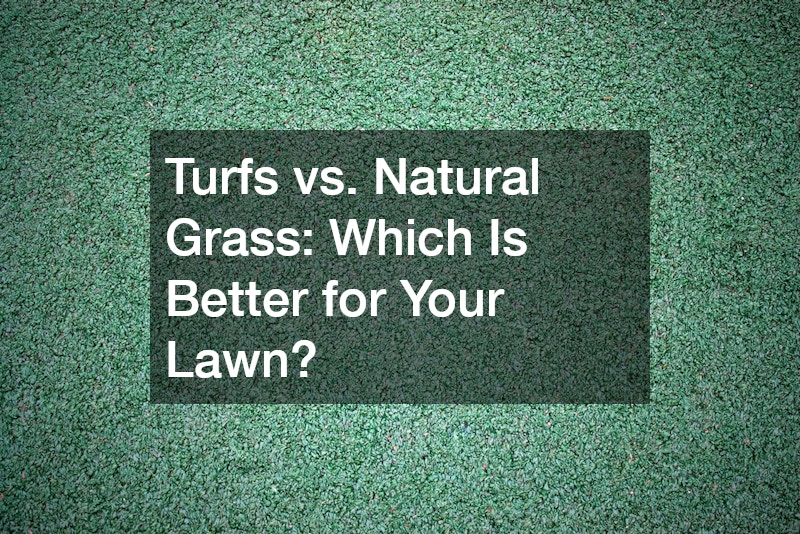Choosing between turfs and natural grass can be a tough decision for Australian homeowners looking to enhance their outdoor spaces. While both options offer distinct advantages, the right choice often depends on factors like budget, lifestyle, climate and maintenance capacity. Understanding the pros and cons of each can help you make a well-informed decision tailored to your property.
The Visual Appeal & Feel
A lush, green lawn is often seen as the hallmark of a well-kept home. Natural grass has long been the traditional option, offering a soft, cool surface that feels pleasant underfoot—especially during the warmer months. The sensory experience of real grass is hard to replicate and many Australians appreciate the natural scent, texture and slight imperfections that give it character.
On the other hand, modern grass have come a long way in mimicking the look and feel of natural grass. High-quality synthetic options now offer realistic colouring, texture and even a comfortable bounce. While older artificial lawns were often easy to identify, today’s options blend seamlessly with garden designs, providing a manicured look all year round without the effort.
Maintenance Requirements
One of the most significant differences between a turf and natural grass lies in the maintenance demands. Natural grass requires regular mowing, fertilising, watering and occasional weed and pest control. This ongoing care can be time-consuming and costly, especially in drier regions of Australia where irrigation becomes a necessity.
In contrast, synthetic surfaces are largely maintenance-free. They don’t need mowing, watering or chemical treatments. A simple occasional rinse and brush are usually enough to keep them looking fresh. This low-maintenance aspect makes them ideal for busy households or holiday homes where regular lawn care may not be practical.
Environmental Considerations
Environmental impact is another crucial aspect to consider. Natural grass provides benefits such as oxygen production, cooling effects through transpiration and habitats for small wildlife. However, maintaining it often requires significant water usage, along with fertilisers and pesticides that can run off into local waterways.
Synthetic turfs conserve water and eliminate the need for chemicals, but they’re typically made from plastics and can contribute to landfill waste once they reach the end of their life cycle. Moreover, artificial lawns can become quite hot under the Australian sun, potentially affecting local temperatures and making the surface uncomfortable for barefoot walking or pets.
Durability & Longevity
For families with kids or pets, the durability of the lawn is a major concern. Natural grass can suffer from wear and tear, developing bare patches and mud zones in high-traffic areas. Recovery can be slow, particularly in colder seasons or shaded areas.
Synthetic grasses are built to endure heavy use and extreme weather conditions. They maintain their appearance year-round and are particularly suited to high-traffic zones like playgrounds or pet runs. Depending on the quality and usage, synthetic turf can last between 10 to 20 years, offering long-term reliability.
Cost Comparison
Initial and long-term costs also vary considerably between the two options. Laying natural grass is often cheaper upfront, especially if using seed rather than rolls. However, the ongoing costs for watering, fertilising, mowing equipment and lawn care services can add up over time.
Artificial grass requires a higher initial investment, including ground preparation and professional installation. However, with minimal maintenance costs and no water bills or lawn services, they often become cost-effective in the long run. For homeowners looking at their lawn as a long-term investment, synthetic turf may offer better value over time.
Seasonal Adaptability

Australia’s diverse climate—from the tropical north to the temperate south—can impact lawn performance. Natural grass varieties like buffalo or kikuyu can thrive in many areas but may struggle during periods of drought or extreme heat without irrigation. Grass can also go dormant in winter, losing its vibrancy.
A synthetic turf remains green and uniform regardless of weather, making it appealing in regions with unpredictable rainfall or water restrictions. They’re a reliable solution for maintaining curb appeal without seasonal fluctuations.
There’s no one-size-fits-all answer when it comes to choosing between turf and natural grass. Both options have their own benefits and challenges. Natural grass offers aesthetic richness, environmental advantages and a traditional charm. Synthetic grass delivers a consistent appearance, minimal maintenance and resilience in challenging climates.
Ultimately, the right choice depends on your property’s specific conditions, your budget and how much time you’re willing to invest in upkeep. By weighing the pros and cons, you can select a lawn solution that aligns with your needs and enhances your outdoor living space for years to come.

